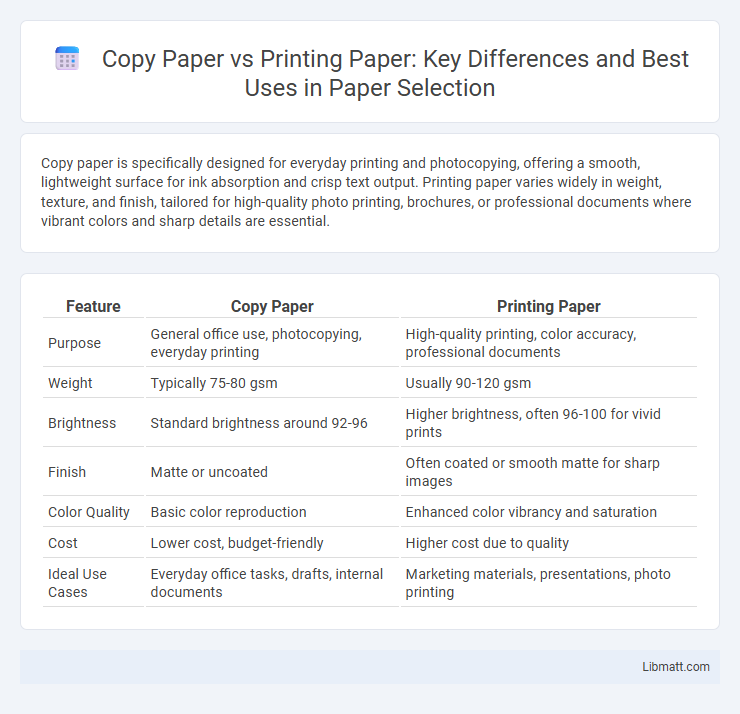Copy paper is specifically designed for everyday printing and photocopying, offering a smooth, lightweight surface for ink absorption and crisp text output. Printing paper varies widely in weight, texture, and finish, tailored for high-quality photo printing, brochures, or professional documents where vibrant colors and sharp details are essential.
Table of Comparison
| Feature | Copy Paper | Printing Paper |
|---|---|---|
| Purpose | General office use, photocopying, everyday printing | High-quality printing, color accuracy, professional documents |
| Weight | Typically 75-80 gsm | Usually 90-120 gsm |
| Brightness | Standard brightness around 92-96 | Higher brightness, often 96-100 for vivid prints |
| Finish | Matte or uncoated | Often coated or smooth matte for sharp images |
| Color Quality | Basic color reproduction | Enhanced color vibrancy and saturation |
| Cost | Lower cost, budget-friendly | Higher cost due to quality |
| Ideal Use Cases | Everyday office tasks, drafts, internal documents | Marketing materials, presentations, photo printing |
Introduction to Copy Paper vs Printing Paper
Copy paper and printing paper differ primarily in weight, brightness, and finish, tailored for specific office or printing needs. Copy paper, typically 20 lb weight with a brightness around 92%, is designed for everyday inkjet and laser printers, offering smooth printing and cost-efficiency. Printing paper often boasts higher brightness levels and a heavier weight, such as 24 lb or more, providing enhanced sharpness and durability for professional documents and high-quality print projects.
Key Differences Between Copy Paper and Printing Paper
Copy paper is typically lightweight, around 20 lb bond, designed for everyday use in copiers and printers with moderate ink coverage, ensuring smooth feed and minimal jams. Printing paper often features higher brightness, a heavier weight such as 24 lb or more, and a smoother finish, optimized for high-resolution images and vibrant color reproduction in professional printing. Your choice depends on the project's demands: copy paper suits standard text documents, while printing paper enhances quality for marketing materials and detailed graphics.
Material Composition and Quality
Copy paper and printing paper differ primarily in material composition and quality, with copy paper typically made from wood pulp containing higher filler content for smoothness, ideal for everyday document printing. Printing paper often features a higher cellulose percentage and reduced fillers, resulting in superior brightness, opacity, and ink absorption tailored for professional graphics and photo printing. The enhanced fiber quality in printing paper minimizes ink bleed-through and curling, ensuring sharper images and more durable print output.
Weight and Thickness Comparison
Copy paper typically weighs between 20 to 24 pounds (75 to 90 gsm), offering a standard thickness suitable for everyday printing and copying tasks. Printing paper, especially premium varieties, ranges from 24 to 32 pounds (90 to 120 gsm) or higher, providing greater thickness and durability for high-quality prints and professional documents. The thicker weight and density of printing paper enhance opacity and reduce show-through, making it ideal for presentations and marketing materials.
Brightness and Opacity Factors
Copy paper typically features a brightness level between 92 and 96, ensuring crisp text and clear images for everyday printing needs, while printing paper often offers higher brightness levels above 97 to enhance color vibrancy and sharpness in high-quality prints. Opacity in copy paper ranges around 88-92%, reducing show-through for double-sided documents, whereas printing paper tends to have opacity values exceeding 95%, minimizing bleed-through and providing superior image reproduction. Brightness and opacity are critical factors influencing the choice between copy paper and printing paper, affecting readability, color fidelity, and overall print quality.
Best Uses for Copy Paper
Copy paper is best suited for everyday office tasks such as printing documents, making photocopies, and drafting internal memos due to its lightweight and cost-effective nature. It typically ranges from 20 to 24 pounds in weight, providing sufficient opacity and smoothness for laser and inkjet printers without causing jams. For high-quality prints, brochures, or color projects, printing paper with higher brightness and weight is preferred, but copy paper excels in efficiency and affordability for routine printing needs.
Ideal Applications for Printing Paper
Printing paper is designed with a smoother surface and higher brightness to ensure sharp image reproduction and vibrant color output, making it ideal for high-quality print jobs such as brochures, flyers, and marketing materials. Its weight and finish provide durability and resistance to ink bleeding, which is essential for professional documents and photo printing. Unlike copy paper, printing paper supports a wide range of printing technologies including inkjet and laser printers, enhancing versatility and print precision.
Cost Comparison: Copy Paper vs Printing Paper
Copy paper typically costs less per ream than printing paper due to its standard thickness and brightness, making it ideal for everyday use and bulk printing. Printing paper often features higher quality attributes such as enhanced brightness, smoothness, and weight, which increases its price but produces sharper, more vibrant prints. Businesses balance cost and quality by selecting copy paper for high-volume documents and reserving printing paper for marketing materials or presentations requiring superior visual appeal.
Environmental Impact and Sustainability
Copy paper typically has a higher environmental impact than printing paper due to lower recycled content and less sustainable sourcing practices. Printing paper often incorporates certified sustainable fibers, such as FSC or PEFC, and uses more eco-friendly production methods that reduce carbon emissions and water usage. Choosing printing paper with high post-consumer recycled content and eco-labels significantly promotes sustainability by minimizing deforestation and landfill waste.
Tips for Choosing the Right Paper for Your Needs
When choosing between copy paper and printing paper, consider the paper weight and finish to match your specific printing requirements. Copy paper is typically lightweight and ideal for everyday documents, while printing paper offers higher brightness and smoother surfaces for professional-quality prints. Ensure your selection aligns with your printer's specifications and the purpose of your print projects to achieve the best results.
copy paper vs printing paper Infographic

 libmatt.com
libmatt.com